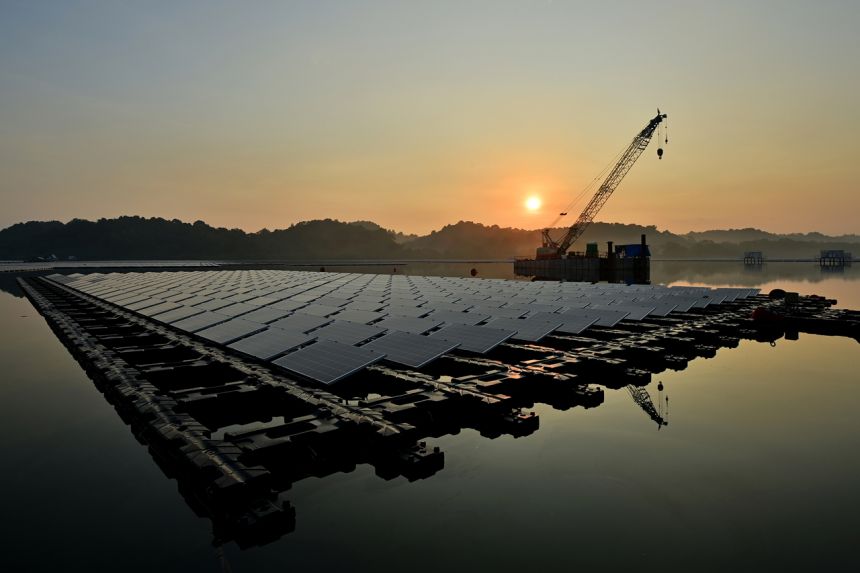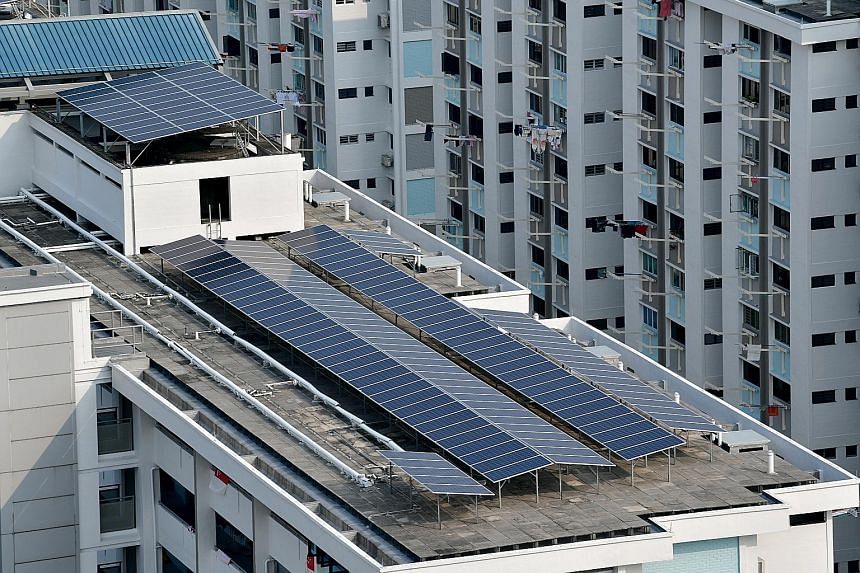Building Sustainable Cities
Energy from sun viable source of green power
Solar energy produces no emissions, cuts our reliance on natural gas and is more efficient, cheaper than other sources of power

Singapore plans for solar capacity to quadruple to 1.5 gigawatt-peak by 2025. The Sembcorp Tengeh Floating Solar Farm (above) will produce 60 megawatt-peak of energy, enough to power around 16,000 4-room Housing Board flats for one year.
PHOTO: ST FILE
Teh Shi Ning
Follow topic:
Solar panels are no longer a rarity in Singapore. But they remain largely out of sight - up on Housing Board (HDB) block rooftops or floating on secluded reservoirs. And the 440 megawatt-peak (MWp) energy that existing panels can harvest would meet a mere fraction of Singapore's total energy needs.
But this is changing rapidly. The Government plans for solar capacity to quadruple to 1.5 gigawatt-peak (GWp) by 2025, before rising to 2 GWp by 2030. This would meet about 4 per cent of Singapore's current electricity demand.
The 2025 goal is "very ambitious, but also achievable if all stakeholders work hand-in-hand", says Dr Thomas Reindl, deputy CEO, Solar Energy Research Institute of Singapore (Seris), National University of Singapore.
In fact, accelerating solar deployment is critical to Singapore's transition to cleaner energy.
Today, 95 per cent of Singapore's electricity is generated from imported natural gas. That is one of the cleanest fossil fuels available - burning natural gas produces half the carbon emissions coal would.
Still, this adds to emissions at a time when scientists are warning that emissions must be slashed to net zero by 2050 if the world hopes to curb the rise in global temperatures to 1.5 deg C and avoid climate catastrophes.
Why solar energy is suitable
The benefits are clear. Solar energy is clean, producing no emissions. Capturing it locally boosts energy security, reducing reliance on natural gas imports. And solar technology is now more efficient and cheaper - the cost of silicon solar modules has fallen more than 80 per cent over the last decade.
And Dr Reindl agrees, saying: "In the absence of other renewable energy resources such as wind (there is very little wind around the equator), hydropower (no big river streams here) and without sufficient land for growing biomass, harvesting the sun's energy is the most viable form of green electricity generation in Singapore."
Costs are also falling thanks to a global surge in demand. Last year, 130 GWp of solar capacity was installed despite the pandemic, bringing the total installed capacity globally to 760 GWp.
But there are challenges too. Sunshine over Singapore may be plentiful but harvested solar power is intermittent, varying with cloud cover and humidity. Its highly built-up, land-scarce urban landscape also means mass deployment of solar panels requires more creativity.
HDB blocks offer a perfect platform
With so many buildings, rooftops have been an obvious canvas. And since 2014, solar photovoltaic (PV) systems have gradually been added to many HDB blocks.

The roll-out of the government's SolarNova programme is also picking up steam. The sixth solar leasing tender - called in March - brings its total commitment to 6,901 HDB blocks with a total solar capacity of 330 MWp, enough to power 82,500 4-room flats.
The aim is for total capacity deployed under the SolarNova programme - which also covers schools, community centres and other public sector buildings - to rise to 540 MWp by 2030.
Private homes, too, are increasingly tapping on the sun's power. City Developments Limited (CDL), for one, has included solar panels in its condominium developments for several years now.
CDL's chief sustainability officer Esther An shares that one of its new residential developments will harness enough solar energy to power 30 per cent of what it consumes, including the needs of its clubhouse, function rooms, swimming pool pumps and gym.
Also on the rise is the number of landed property dwellers with solar-panelled roofs over their heads.
Cost has much to do with it. The levelized cost of electricity from new solar panels is now under 10 cents per kilowatt hour (kwh), lower than the current regulated tariff of about 25 cents per kwh.
That is why no direct subsidies are provided to incentivise solar adoption.
But one nudge in that direction is the Energy Market Authority's bid to make it easier for solar adopters to sell excess solar power back to the grid and get paid through their monthly bills.
While the math works out over the longer term, the upfront cost of solar installations is significant. It ranges from S$18,000 for a terrace house roof to S$36,000 for larger bungalows.
Therefore, it helps that the local banking sector has been keen to support solar adoption, Dr Reindl says.
A bright spot for businesses
The emergence of solar leasing businesses is also shaking things up.
Electricity from large solar installations, feasible on factory rooftops, can now cost under 10 cents per kwh. This creates a business case for solar leasing, or what is sometimes termed as a "zero upfront solar solution".
Such a company installs, owns and operates the solar system on a building, then sells electricity back to the building owner at a discount to the usual electricity tariff.
Private sector solar PV systems made up 235.5 MWp, or over half of Singapore's total solar capacity as of the first quarter of 2021, double what it was two years ago.
Dr Reindl also believes that a greater focus on sustainability among businesses will continue to drive interest up.
But for a developer like CDL - which has pledged to achieve net zero operational carbon for all the buildings it directly owns by 2030 - solar panels are only part of the solution.
"Going net zero will be extremely challenging for Singapore's buildings due to the limited spaces that we can install solar panels in our tall and narrow buildings… Renewable energy certificates and carbon offsets will need to be part of our overall strategy to go net zero," says CDL's Ms An.
This is also why CDL has partnered with Seris to test-bed building-integrated photovoltaic (BIPV) innovations - including a solar art wall integrated into outdoor balustrades at City Square Mall.
Dr Reindl believes such BIPV innovations, which turn building facades into power generators, have great potential.
BIPV modules receive only half the sunshine rooftop panels do and are thus less cost-effective. But as a replacement for typical wall cladding on new buildings, the BIPV solution pays for itself in eight to 10 years.
Meanwhile, Seris is working on easy to deploy "plug and play" solutions to retrofit existing buildings with very lightweight PV panels.
"Solar has a great future in Singapore, not only for providing green electricity, but also for creating jobs, economic value, and innovations," says Dr Reindl.
"(These new technologies) would not only solve our own challenges but also have great opportunities for exporting our know-how to other megacities in the tropics and beyond," he adds.
"(These new technologies) would not only solve our own challenges but also have great opportunities for exporting our know-how to other megacities in the tropics and beyond," he adds.
By the numbers
-
1.5 GWp
Singapore's target for solar power capacity by 2025
-
95%
Singapore's electricity generated from imported natural gas
-
80%
Plunge in prices of silicon solar modules over the past decade
-
2,470
Number of HDB blocks with solar panels installed as of last December, with work in progress on another 2,080
Making solar panels affordable and accessible
It was through working with clients on sustainability issues that UOB gleaned insight into pain points such as high electricity bills, says Mr Karunia Tjuradi, UOB's head of sector solutions group, group wholesale banking.
This, coupled with a maturing of solar technology, made it practical and economical enough to adopt, led the bank to launch its U-Solar programme in 2019.
The solar power financing platform links businesses and homeowners keen to install solar panels on their factories, office premises and homes, with solar project developers and contractors.
U-Solar was rolled out in UOB's key markets: Singapore, Malaysia, Thailand and Indonesia.
"Located near the equator, South-east Asia is well-positioned to take advantage of the relatively high solar irradiance (output of light energy from the sun) levels it receives," says Mr Tjuradi.
By July 2021, it had facilitated the generation of 163.9 gigawatt hours of solar power across the four markets. That translates into more than 81,500 tonnes of CO2-equivalent in greenhouse gas emissions avoided.
This would be the equivalent of growing 1.35 million new tree seedlings over 10 years, or taking more than 17,737 cars off the road for a year.
U-Solar covers everything from green financing for solar engineering, procurement, construction and commissioning contractors, to preferential rates for solar panel installation and maintenance packages for end-users.
One notable green loan made under the programme was UOB Thailand's 1.26 billion baht (S$52.5 million) loan to solar power developer BECIS-Symbior, funding up to 75 MWp of its installed capacity and supporting its promotion of clean energy solutions.
Individual homeowners who use a UOB credit card to purchase a U-Solar package - offered by the bank's solar partners - can pay for their solar installations in interest-free instalments over three years.
In Singapore, UOB's partners are SolarGy, Sunseap and SunPro Energies.
Building Sustainable Cities is a series sharing insights on how individuals and businesses can take action to forge a cleaner, greener tomorrow.
This is the seventh of a 15-part series in collaboration with


